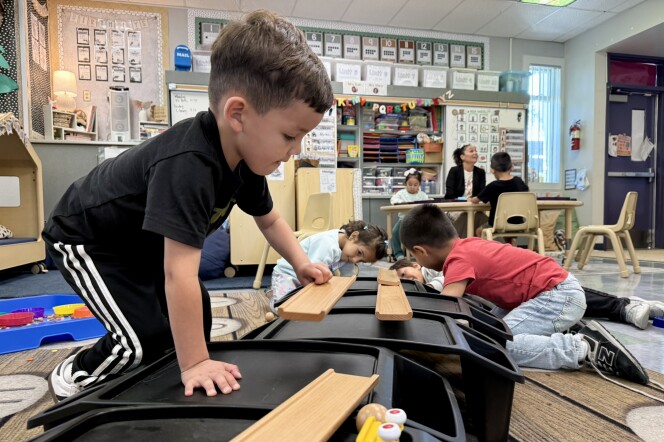Truth matters. Community matters. Your support makes both possible. LAist is one of the few places where news remains independent and free from political and corporate influence. Stand up for truth and for LAist. Make your year-end tax-deductible gift now.
California adopts tougher methane rule for landfills to curb planetary warming

Your trash, or the place where it ends up, is one of the most serious contributors to global warming. After livestock, landfills are the second-largest source of methane emissions in California, responsible for more than 20% of the state’s output.
That’s why the California Air Resources Board took action Thursday to monitor and capture landfill gases.
Methane is a potent greenhouse gas that is generated from the breakdown of waste. Even though it’s a short-lived climate pollutant compared to long-lasting carbon dioxide, it severely exacerbates human-caused climate change.
The new rules will eventually require landfill operators to take action when a satellite or airplane detects a methane leak, improve routine leak monitoring and reporting and mandate stronger action on recurring issues. The protections will add to a suite of regulations the state passed in 2010, which made California the first state to develop stricter standards than the federal government.
“This is another example of California’s leadership in reducing emissions and harmful climate-warming pollutants across all sources. With these updates, California will be able to more efficiently and effectively monitor methane sources to detect and remedy leaks quickly,” CARB Chair Lauren Sanchez said in a press release.
The board reported that the state’s methane satellite, which passes by four to five times a week, has helped stop 10 large leaks since May.
“We believe that many operators would be interested in adopting these technologies to reduce the need for costly labor, especially as the number of mature technologies increases over time,” said air resources engineer Quinn Langfitt, who introduced the regulator’s proposal at a public hearing on Thursday.
The changes, which will affect 188 landfills in the state, are part of meeting the state’s goal to reduce methane emissions by 40% below 2013 levels by 2030.
Officials said the new rules could reduce landfill emissions by 427,000 metric tons of carbon dioxide equivalent per year. They would create $34 million in social benefits and cost landfills around $12 million, with the largest bearing the brunt of the price tag.
A recent report backed up the agency’s findings: By 2050, landfill emissions could be reduced by more than half and up to 64% by the end of the century, according to a March analysis by Industrious Labs. The group noted that California landfills emit 7.2 million metric tons of carbon dioxide equivalent of methane annually, which has “the same climate impact as driving 1.7 million cars for one year.”
But even though the board passed the new rules, they won’t go into effect immediately; staff will need to address a slew of clarifying questions raised by the public and board members during the hearing.
CARB board member Diane Takvorian supported the rule but pushed for a public-facing dashboard to show when and where emissions plumes are detected.
“People are asking for basic information,” Takvorian said, noting that technology is moving fast and that people need information now, not in years. She and others recommended an 18-month technology review after the rule goes into effect. They also suggested that the state and landfills share any data with the public as soon as possible.
“If we have the data, we should share it,” board member Hector De La Torre said.
John Kennedy, senior policy advocate for the Rural County Representatives of California, said he is “supportive of efforts to reduce emissions.” His group represents more than two-thirds of the landfills to which the standards would apply. Kennedy wants to ensure that the implementation is feasible for local governments “while protecting the communities that are close to those landfills.”
A spokesperson from Waste Management, which does business as WM, representing facilities across the state, thanked staff for the updated plan, but said he hopes they will work with the industry on site-specific conditions, which of the new rules are “necessary and useful to diagnose conditions,” and a framework for using alternative monitoring technologies.
Multiple residents from the Los Angeles community of Val Verde attended the meeting. They said they have suffered because of widespread noxious odors and hazardous gas emissions from the Chiquita Canyon Landfill in recent years. Brandi Howse, who spoke during public comment, said she has lived about 1,000 feet from the landfill for 27 years.
Howse said she has experienced clouds of methane and other gases at her home.
“You become dizzy, disoriented, nauseous. You get headaches, burning sinuses and bloody noses,” Howse said. “We are left to be concerned with long-term effects. I know that myself and my neighbors to my left and my right have all had cancer.”
Community members from the Kern County community of Avenal approached the podium to say that the landfill in their community is causing health concerns, including cancer, and people are leaving the town because of it.
“The smell is really bad,” said Leticia Luna, who moved to Avenal 15 years ago. “People are leaving our community because their homes are not safe, and when they leave, they find it difficult to sell because we live very close to the landfill.”
While many groups applauded the new rule, Jane Williams, executive director of California Communities Against Toxics, said it is a “real first step,” and that CARB needs even stronger rules to prevent fires and large emission leaks at landfills.













